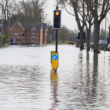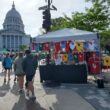Bringing local government home
If there is a rat in the kitchen of a Boston restaurant, residents are going to know about it. Using the Mayor’s Food Court.com, on-line visitors can review inspections for area eateries before they dine. “That is the most visited site because it really affects people,” says Rajesh Pareek, manager of e-government services for the city.
As never before, the Internet provides the public with convenient access to local government and community-based information. For nearly every city- or county-related task that previously required time at and transportation to a government office, there are now virtual offices where residents can conduct their business with speed and security. By eliminating paperwork and mailing costs, e-government also affords some cost savings to local budgets.
The e-citizen
“Virtual government” allows residents to perform many tasks online that previously would have required them to make multiple phone calls or dart across town to the appropriate city or county office. For example, Boston’s online “Who Am I?” function allows residents to complete multiple queries in one fell swoop. A user enters his street address and quickly learns his neighborhood ward number, the location of his voting precinct and the names of his city councilor and neighborhood liaison to the city government. He also will be able to learn the dates of his trash pickup and street cleaning services when the city completes the data compilation.
Similarly, Riverside County, Calif., is allowing residents to make property queries online. Residents enter a street address or parcel number and review a report that includes the land value; the value of the structure on the land; the tax rate; the taxes paid for the current period; the taxes due; the payment status; and the due date.
Riverside County collects property taxes totaling $1.1 billion for 700,000 parcels. Collection periods are in April and December. Last March, the county launched an online tax payment service through Atlanta-based ezgov.com, and 500 payments (totaling $500,000) were received electronically for the April collection period.
All payments are made by electronic funds transfer. A user visits a secure portion of the site to enter his name, mailing address, phone number, e-mail address, bank account number and the routing number from a check. He receives a transaction confirmation number for reference.
The county expects the new service to create significant savings, both inside and outside the government, by reducing paperwork, mailing costs and labor. “We wanted to increase efficiency and productivity in the office,” says Tom Mullen, chief deputy treasurer/tax collector for the county. “With an electronic transaction, everything is automated. It’s much faster.”
Since electronic payments typically are processed more quickly than paper checks, online users can pay at the last minute, if necessary. Boston residents can pay parking tickets online using a credit card three days after receiving a ticket, on the day the payment is due or any time in-between.
Starting this month, folks in Upper Arlington, Ohio, will be able to pay their parking tickets and stormwater utility bills online. “We’re seeking a higher level of convenience,” says City Manager Richard King. Since a significant number of residents have Internet access at home, it makes sense to offer them online payment options, he adds. With the help of New York-based company govWorks.com, Upper Arlington started developing its online payment system in February.
Fairfax County, Va., allows residents to make payments online both by credit card and electronic bank transfers, and both methods have been well received. The county collected $4.3 million online in taxes, tickets and other payments last year. “We’re allowing people to do business when it’s convenient for them,” says Dave Molchany, chief information officer for the county. “The web site offers a different level of service.”
Online vs. in line
Speed and efficiency are the most common reasons local governments cite for placing services online. Many government web sites give residents the opportunity to handle basic tasks — such as obtaining a dog license (Ferguson, Mo.; King County, Wash.; Solano County, Calif.); applying for a library card (Fairfax County); renting a city recreational facility (Ferguson); or even searching for a job (Boston, Fairfax County) — without leaving their homes.
While many local government web sites cannot accept applications online, they do allow residents to download the necessary forms, which they can fill out at home and mail or hand-deliver to the appropriate office. “People really appreciate it,” says Julie Szymula, assistant city manager of Ferguson. “No one likes doing more errands than they have to.” Ferguson recently developed its web site with assistance from PureLogix, Bridgeton, Mo.
Working online can eliminate physical trips to city and county offices, as well as phone calls. Until last September, when Albany, Mo., residents reported problems such as burned-out streetlights or potholes, they either visited or called the city. Whoever answered the call wrote down the problem and hand-delivered the message to the appropriate department.
The system was very inefficient, says City Administrator Tom Lesnak. “There was no paper trail,” he says. “That was not a very good way of tracking work orders from residents.”
Now, residents can report a problem 24 hours a day using OurTown2000 software from Govt.com, Lewisburg, W. Va., via e-mail from the city web site. When they send an e-mail, they receive a confirmation e-mail in return. The city receives about a dozen e-mails with work requests per month, according to Lesnak.
Lodging work requests or complaints via e-mail has proven to be effective in many different cities and counties. Because the Internet is “active” 24 hours a day, seven days a week, residents can file complaints at any time.
Usually, no one likes to hear complaints. But in Maricopa County, Ariz., the Environmental Services Department (ESD) is welcoming comments from residents because they are providing much-needed assistance.
For years, Phoenix and its surrounding municipalities have struggled to comply with federal standards for particulate matter (i.e., dust). Air quality has declined steadily, literally making every last pollutant a federal case. (EPA has stepped in to enforce regulations.)
To help reduce air pollution, ESD has developed its presence on the county web site and added a direct e-mail communications mechanism. “We are trying to make it as easy as possible for people to communicate with us,” says Shelia Brott-Loewe, operations manager for the community services division of the department. “The way of the web is the way to go.”
Residents can send complaints about sewage, construction sites and other environmental issues. Last year, the county started a Smoking Vehicle Program to encourage residents to report vehicles with excessive emissions problems. They can report problems by phone or by e-mail, and they must give the car’s license plate number so that county employees can follow up with the owner.
Through the department’s Dust Devil Academy, residents can report on construction sites or other areas with excessive dust. They are required to give the exact street address or intersection where the problem occurred, and provide as much information as possible (i.e., type of dust, materials being used).
The department receives approximately 15 complaints per day, more than half of which reference smoking vehicles, Brott-Loewe says. To make it easier for residents to lodge complaints, the department is developing an online checklist for them to use, instead of forcing them to create their own messages. “People frequently leave out information and details, and we end up playing phone tag or trying to track people down via e-mail,” Brott-Loewe says. “We want to make it easier for people to file complaints to help maintain air quality.”
The digital divide
There is no question e-government makes things easier. Residents do not have to drive anywhere, call anyone, go to the mailbox or even leave their chairs to get information about city or county operations. They can get all the information they need and even pay a couple of bills with the click of a mouse.
Of course, that applies only to those residents with Internet access. And that does not include everyone. The “digital divide,” as it is commonly known, is a classic case of the “haves” vs. the “have-nots.” Lower-income families who cannot afford a home PC, or people who do not work in offices with computer equipment may be shut out of the e-volution without some assistance from their local governments.
To bridge the divide, Fairfax County has implemented non-Internet technology to afford all residents the same conveniences enjoyed by their “connected” neighbors. Through interactive voice response (IVR), residents can use their telephones to pay taxes and traffic fines via credit card; access general county information; and make a variety of queries.
The county also has installed informational touch-screen kiosks at 18 locations, including libraries and shopping malls, where residents can pay taxes and traffic fines, and print forms and applications. “It’s helpful to look at multiple technologies to focus on services for citizens,” Molchany says.
The county spent about $2 million to implement the separate systems. In 1999, the county collected $1.9 million in tax payments just over the IVR system.
Boston also has placed kiosks at libraries, community centers, malls and other popular areas. “The city is always concerned about the digital divide,” Pareek says.
Faceless government
With the prevalence of online and IVR services, one could argue that local governments are in danger of losing touch with their communities. But officials counter by noting that technology has actually opened doors to local government.
For example, late last year, Bloomington, Ind., began broadcasting video coverage of all local public meetings on its web site. Residents can view a live meeting or review previous meetings using RealPlayer online. King County also broadcasts live council and committee meetings over the Internet, reaching residents who might otherwise never attend a meeting.
“It’s not a matter of being impersonal, [it’s a matter of] being convenient,” says Allen Winder, vice president and general manager of public services for J.D. Edwards, a Denver-based software firm. “The trade-off between convenience and personalization is worth it, and people are ready for it.”
“This is a real plus for government,” says Liane Levetan, CEO for DeKalb County, Ga. “We can give better customer service [online].” DeKalb County recently made online tax payments available to residents and soon will add payments for utility bills, parking tickets and other business.
Ultimately, online governing will not detract from the “face” of government because elected officials will still have personal contact with constituents, Molchany says. “That personal service is still here, if people need it,” he explains. “But with online resources, people can spend more time with the people they want to spend time with, instead of with a clerk at a government office.”
Convenience, speed and efficiency are the keys to online government. Building a web page is the first step, and now many governments are looking to enhance their online presence by providing services through their sites. Someday, residents may be able to vote online (for local elections); adopt a pet online; and even renew their drivers’ licenses online — all with no lines, no paperwork and no red tape.



















